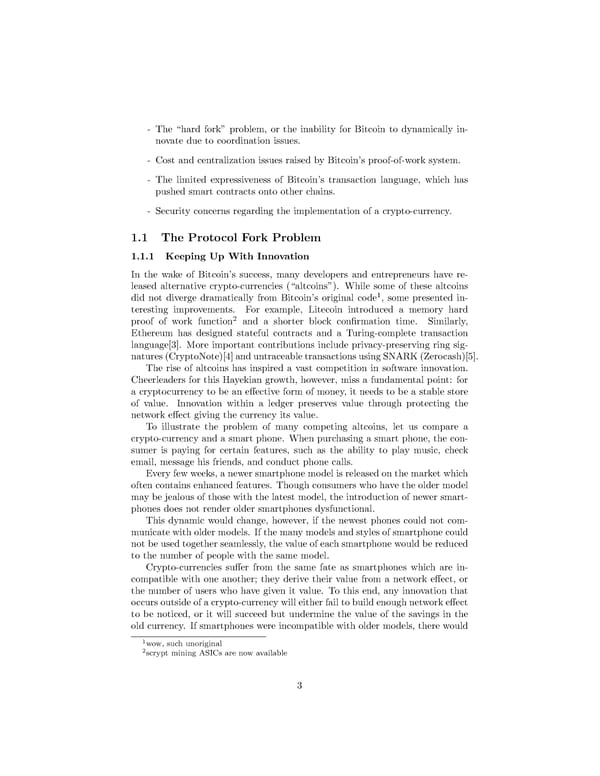- The “hard fork” problem, or the inability for Bitcoin to dynamically in- novate due to coordination issues. - Cost and centralization issues raised by Bitcoin’s proof-of-work system. - The limited expressiveness of Bitcoin’s transaction language, which has pushed smart contracts onto other chains. - Security concerns regarding the implementation of a crypto-currency. 1.1 The Protocol Fork Problem 1.1.1 Keeping Up With Innovation In the wake of Bitcoin’s success, many developers and entrepreneurs have re- leased alternative crypto-currencies (“altcoins”). While some of these altcoins did not diverge dramatically from Bitcoin’s original code1, some presented in- teresting improvements. For example, Litecoin introduced a memory hard 2 proof of work function and a shorter block confirmation time. Similarly, Ethereum has designed stateful contracts and a Turing-complete transaction language[3]. More important contributions include privacy-preserving ring sig- natures(CryptoNote)[4]anduntraceabletransactionsusingSNARK(Zerocash)[5]. The rise of altcoins has inspired a vast competition in software innovation. Cheerleaders for this Hayekian growth, however, miss a fundamental point: for a cryptocurrency to be an effective form of money, it needs to be a stable store of value. Innovation within a ledger preserves value through protecting the network effect giving the currency its value. To illustrate the problem of many competing altcoins, let us compare a crypto-currency and a smart phone. When purchasing a smart phone, the con- sumer is paying for certain features, such as the ability to play music, check email, message his friends, and conduct phone calls. Every few weeks, a newer smartphone model is released on the market which often contains enhanced features. Though consumers who have the older model maybejealous of those with the latest model, the introduction of newer smart- phones does not render older smartphones dysfunctional. This dynamic would change, however, if the newest phones could not com- municate with older models. If the many models and styles of smartphone could not be used together seamlessly, the value of each smartphone would be reduced to the number of people with the same model. Crypto-currencies suffer from the same fate as smartphones which are in- compatible with one another; they derive their value from a network effect, or the number of users who have given it value. To this end, any innovation that occurs outside of a crypto-currency will either fail to build enough network effect to be noticed, or it will succeed but undermine the value of the savings in the old currency. If smartphones were incompatible with older models, there would 1wow, such unoriginal 2scrypt mining ASICs are now available 3
 A Self-Amending Crypto-Ledger Position Paper Page 4 Page 6
A Self-Amending Crypto-Ledger Position Paper Page 4 Page 6